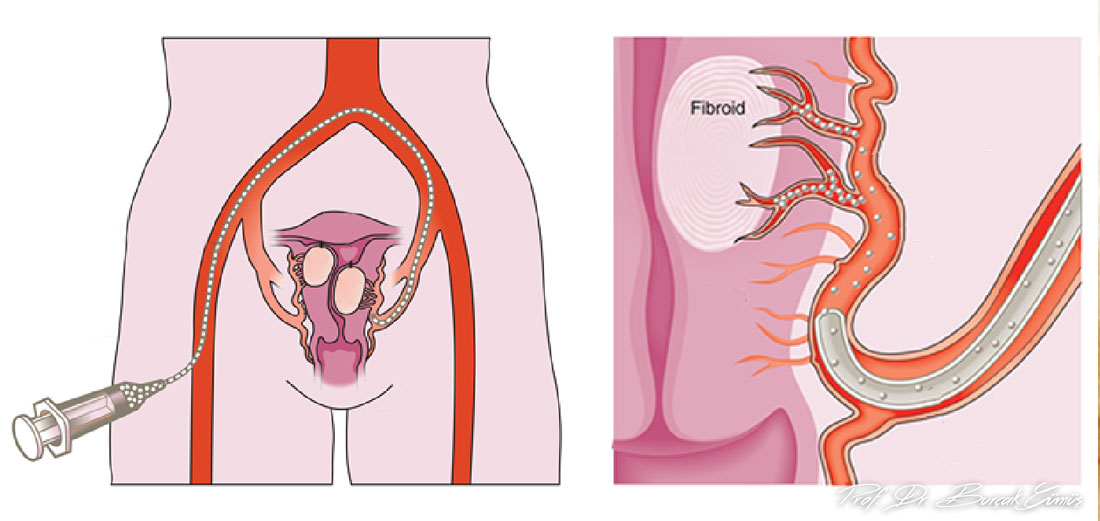| Uterine Fibroid Embolization (UFE) is a minimally invasive procedure designed to shrink fibroids and relieve symptoms like heavy bleeding, pelvic pain, and urinary issues. Unlike traditional surgeries, UFE allows women to preserve their uterus, experience less downtime, and recover faster. This procedure offers a safe, effective solution for women seeking long-term relief from fibroid symptoms without undergoing major surgery. Contact North Texas Fibroids today to schedule your consultation and learn if UFE is the right choice for your fibroid treatment. |
Uterine Fibroid Embolization (UFE) is a minimally invasive procedure that provides lasting relief for women suffering from the symptoms of uterine fibroids. Fibroids are non-cancerous growths that can cause significant discomfort, including heavy menstrual bleeding, pelvic pain, and urinary issues.
Traditionally, surgical options like hysterectomy and myomectomy were the primary treatments, but UFE offers an effective alternative that allows women to avoid major surgery, preserve the uterus, and recover quickly.
This blog will walk you through how UFE works, its benefits, and what you can expect from the procedure to help you determine if it’s the right treatment option for you.
Symptoms of Uterine Fibroids
Recognizing the symptoms of uterine fibroids early can help you seek treatment and prevent further discomfort. Common symptoms that may indicate fibroids include:
- Heavy or prolonged menstrual bleeding: Excessive bleeding that lasts more than seven days or involves large blood clots.
- Pelvic pain or pressure: Persistent discomfort or a sensation of heaviness in the lower abdomen.
- Frequent urination: Pressure from fibroids pressing against the bladder may cause a need to urinate frequently.
- Constipation or bloating: Fibroids can press on the intestines, leading to digestive symptoms.
- Pain during intercourse: Depending on their location, fibroids may cause discomfort during sex.
If you are experiencing any of these symptoms, UFE may offer relief without the need for more invasive surgical procedures.
How UFE Works
Uterine Fibroid Embolization effectively treats fibroids by blocking the blood flow that nourishes them, causing them to shrink. Here is a step-by-step overview of how the UFE procedure works:
- Preparation: To start, the skin is numbed, and a small incision is made in the upper thigh or wrist to access the artery.
- Catheter Insertion: Using real-time imaging, the physician carefully guides a catheter through the artery to the uterine artery supplying the fibroids.
- Delivery of Embolic Agents: Tiny particles are then injected through the catheter to block blood flow to the fibroids, depriving them of oxygen and nutrients.
- Completion: Once the blood supply to the fibroids is sufficiently restricted, the catheter is removed, and a small bandage is applied.
The procedure typically takes around 60–90 minutes, after which most patients can return home the same day or spend a single night in the hospital. Over the next few months, the fibroids gradually shrink, leading to a significant reduction in symptoms.
Typical Benefits
Uterine Fibroid Embolization offers a range of benefits, making it a highly effective and minimally invasive option for treating fibroid symptoms:
- Preserves the uterus: Allows women to retain their uterus, avoiding the need for hysterectomy.
- Reduces heavy menstrual bleeding: Significantly decreases bleeding in women with symptomatic fibroids.
- Improves urinary function – Decreases urinary frequency and urgency caused by fibroid pressure.
- Alleviates pelvic pain and pressure: Provides relief from discomfort associated with fibroids.
- Minimal blood loss: A virtually bloodless procedure, reducing the risk of complications.
- Covered by most insurance providers: Recognized as an effective, covered treatment for symptomatic fibroids.
- Quick procedure and recovery: Lasting approximately 60-90 minutes, with most patients able to return home within 4-6 hours or stay a single night.
- Faster recovery than hysterectomy: Shorter hospital stay, quicker return to work, and fewer postoperative complications.
- Increases confidence and comfort: Reduces soiling events and improves quality of life.
- Boosts physical and emotional well-being: Many patients report significant improvements in both areas post-treatment.
- Low-risk procedure: UFE is a safe option with minimal risk of complications.
- High patient satisfaction: Approximately 90% of women report satisfaction or high satisfaction after follow-up.
These benefits make UFE a popular choice for women seeking relief from fibroid symptoms without undergoing major surgery.
Risks and Complications
As with any medical procedure, discuss all risks and complications with your physician:
- Non-target embolization
- Transient amenorrhea (absence of a women’s menstrual period)
- Common short-term allergic reaction/rash
- Vaginal discharge/infection
- Possible fibroid passage
- Post-embolization syndrome (post-procedure pain, fever, tiredness, and elevated white blood cell count)
- Premature menopause
- The effects of UFE on the ability to become pregnant and carry a fetus to term, and on the development of the fetus, have not been determined.
Is UFE Right for Me?
Determining if Uterine Fibroid Embolization (UFE) is the right treatment for you depends on several factors, including the size, location, and symptoms of your fibroids, as well as your personal health goals.
UFE is an excellent option for women who wish to avoid more invasive procedures, such as a hysterectomy, and who want to preserve their uterus. It is particularly effective for women experiencing symptoms like heavy menstrual bleeding, pelvic pain, and pressure due to fibroids.
Ideal candidates for UFE are those who:
- Have symptomatic fibroids that are causing significant discomfort or impacting daily life.
- Are not planning to become pregnant, as UFE may impact fertility.
- Prefer a minimally invasive option with a shorter recovery time than traditional surgery.
- Are seeking relief from symptoms without the need for major surgery.
A consultation with a specialist is essential to assess your unique condition and goals. At North Texas Fibroids, our experienced team will provide a comprehensive evaluation to determine if UFE is the best treatment option for you, helping you make an informed decision that aligns with your health needs.
Aftercare Tips Following UFE
While UFE is minimally invasive, proper aftercare can ensure a smooth recovery and the best results. Here are some aftercare tips:
- Rest and hydrate: Take it easy for the first few days and stay well-hydrated to aid in your recovery.
- Engage in light activities: Gentle activities, such as short walks, can promote blood circulation and prevent blood clots, but avoid strenuous exercises for at least one week.
- Wear compression garments: Compression stockings help support blood circulation and reduce any swelling in the legs.
- Follow your doctor’s pain management plan: Mild cramping and discomfort are common after UFE, and over-the-counter pain relievers or prescribed medication can help.
- Attend follow-up appointments: Follow-up visits are essential to monitor your healing progress and ensure the fibroids are shrinking as expected.
Following these aftercare instructions will help optimize your recovery and provide the best outcome from your UFE procedure.
Discover Minimally Invasive Relief with North Texas Fibroids
If uterine fibroids are impacting your quality of life, Uterine Fibroid Embolization (UFE) may be the solution you’ve been looking for. This effective, minimally invasive procedure provides long-term relief from fibroid symptoms like heavy bleeding, pelvic pain, and pressure, without the need for a major surgery.
At North Texas Fibroids, our team is dedicated to providing compassionate care, guiding you through every step of the process, from initial consultation to follow-up visits.
Dr. Handley has extensive experience with Uterine Fibroid Embolization (UFE) in the Dallas-Fort Worth, TX, area. Our non-surgical approach to the treatment of fibroids can help relieve pelvic pain, heavy menstrual bleeding, and many other symptoms. Give us a call today at (972)736-9980 to see if UFE can provide relief for your symptoms.
Frequently Asked Questions (FAQ)
An FAQ section can address common patient concerns:
How effective is UFE in treating fibroid symptoms?
Approximately 85-90% of women experience significant symptom relief, including reductions in pain and bleeding.
Will I still be able to get pregnant after UFE?
While UFE preserves the uterus, it can sometimes impact fertility. Discussing family planning with your doctor is essential before treatment.
How soon can I resume normal activities after UFE?
Most patients return to light activities within a few days, with a full return to normal activities in about a week.
Is UFE covered by insurance?
Yes, most insurance companies cover UFE as a treatment for fibroids, but checking with your provider is always recommended.
What are the long-term benefits of UFE?
UFE offers significant and lasting relief from fibroid symptoms without major surgery, allowing for an improved quality of life and quicker recovery.
Uterine Fibroid Embolization Specialist in Dallas
Learn more about uterine fibroid embolization in Dallas by clicking on the links below:

